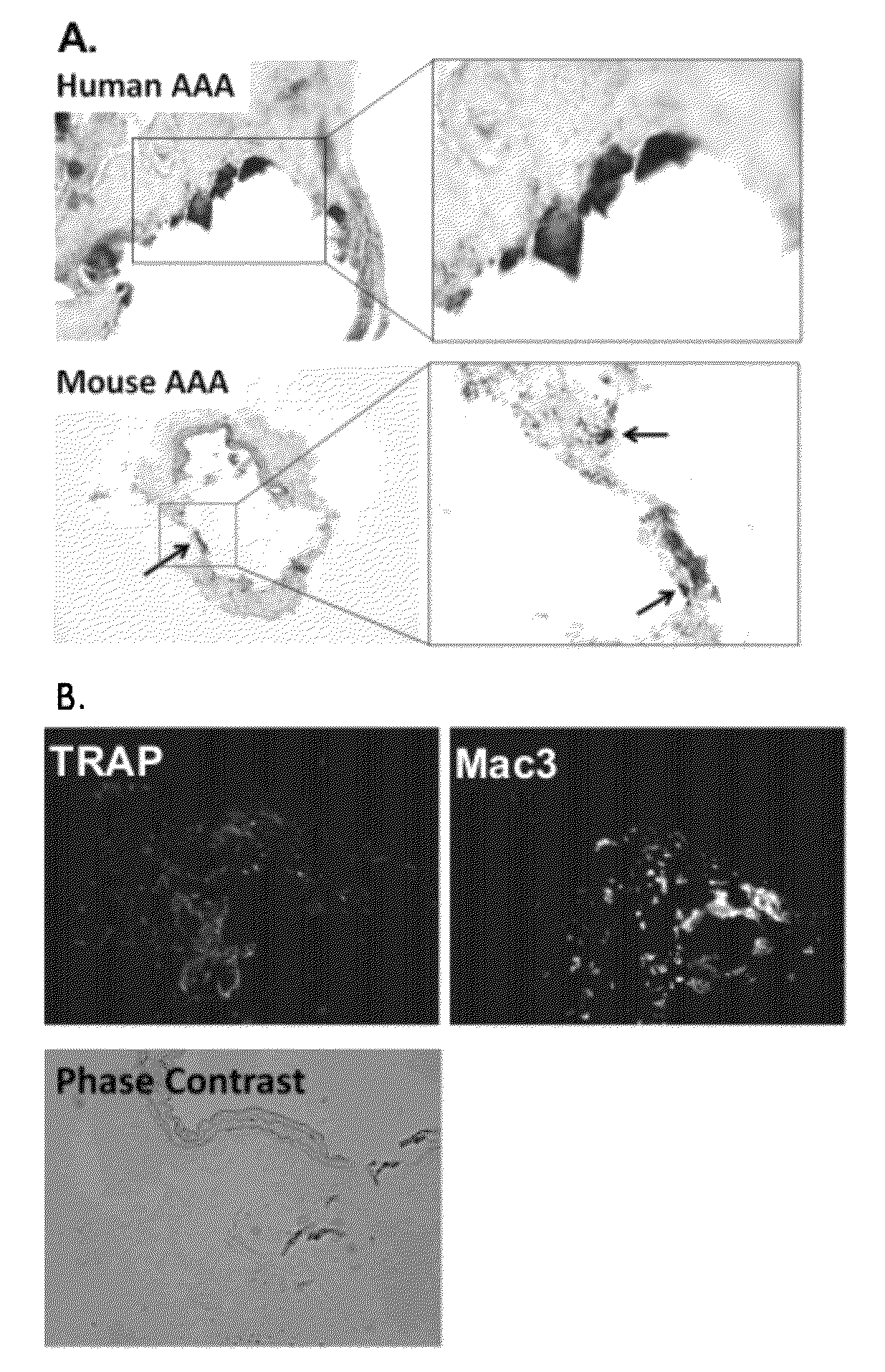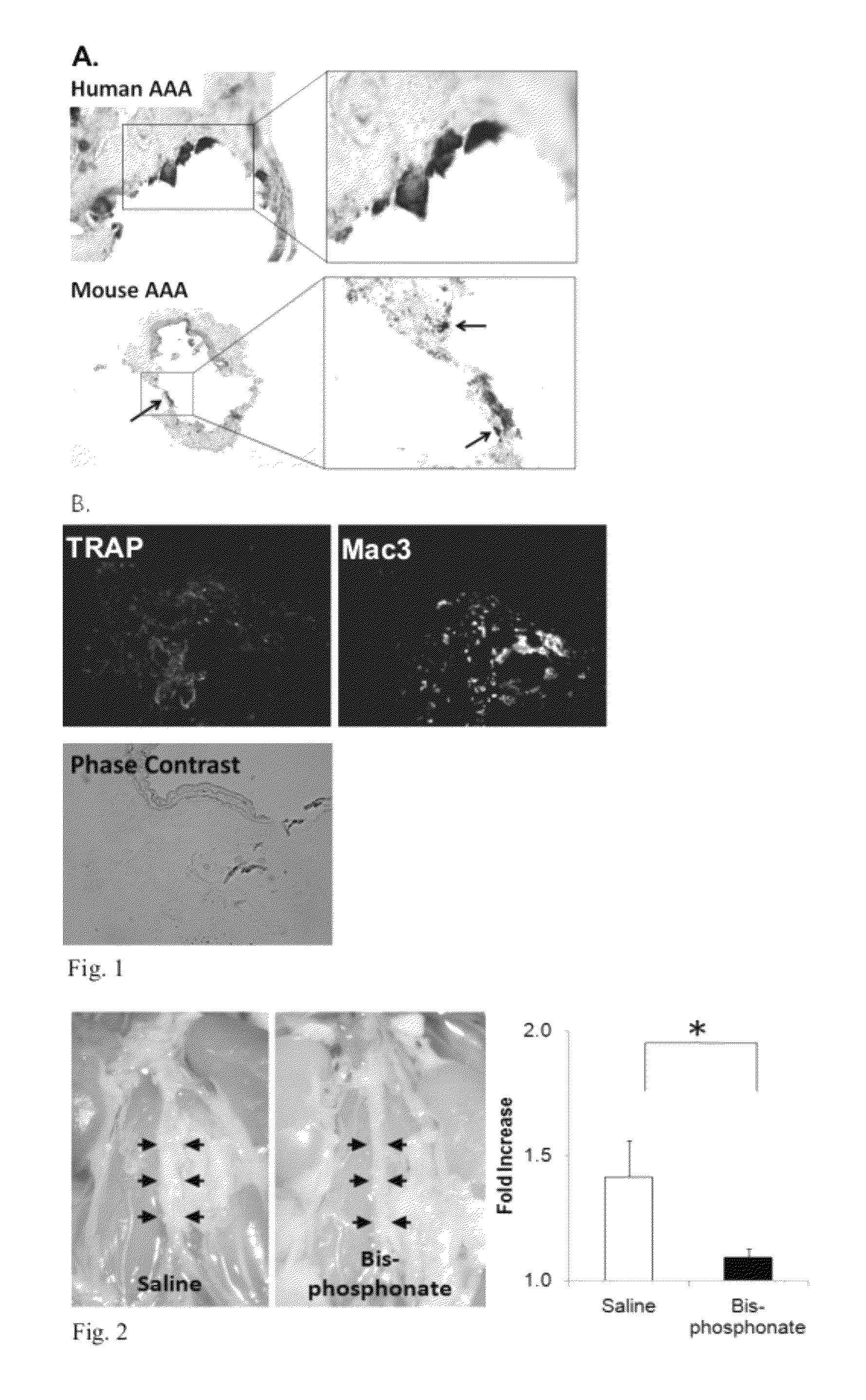Methods of treating aneurysm
a technology of aneurysm and aneurysm, applied in the field of methods, can solve the problems of high risk of adverse clinical events, improved survival rate, and high arterial calcification (too much mineralization of the arteries)
- Summary
- Abstract
- Description
- Claims
- Application Information
AI Technical Summary
Benefits of technology
Problems solved by technology
Method used
Image
Examples
example 1
[0070]Recent studies have suggested calcification in arteriosclerosis is an organized and regulated process with many similarities to bone mineralization, which is regulated by osteoclast-like cells (“OLCs”). Bisphosphonate has previously been successfully used in clinics to treat osteoporosis by inhibiting osteoclast activity. In this example, the inventors demonstrate that the inhibition of OLCs with bisphosphonate leads to an inhibition of AAA development.
[0071]Initially, the inventors identified robust calcification in human AAA samples. The inventors have also identified the existence of OLCs in the medial layer of aneurismal aorta, which were barely detected in age matched aortic tissues from autopsy and stenotic disease both by tartrate-resistant acid phosphatase (“TRAP”) staining, a conventional staining for osteoclast, and immunohistochemistry for osteoclast marker, TRAP (see FIG. 1). The inventors also have identified calcification and OLCs in experimental calcium chloride...
example 2
[0072]In this example, the inventors have tested the effect of the nitrogen-containing bisphosphonate compound pamidronate (Bis) on pre-existing (induced) AAAs in mice (over 5 weeks vs. control treatments; see FIG. 3A) by delaying the treatment until 7 days after aneurysm induction; treatment with weekly injection of bisphosphonate immediately halted further growth of the aneurysm whereas the aneurysms in the control animals (Saline) kept growing significantly larger. In addition, the inventors have extended their studies to cover the other major subclass of bisphosphonates (i.e., non-nitrogenous bisphosphonates) by studying the effect of etidronate (7.5 mg / kg i.v.) on aneurysm formation over 7 days (see FIG. 3B). The dose of etidronate was equivalent to FDA approved dose for Paget's disease (5-10 mg / kg).
[0073]In FIGS. 4 and 5, the inventors demonstrate the long term (6 weeks) effect of bisphosphonate on aneurysm formation by pamidronate and etidronate, respectively. The bisphosphon...
example 3
[0074]In this example, the inventors have tested the short and long term effect of the newer generation of nitrogen-containing bisphosphonate compound zoledronate (ZA) (0.1 mg / kg, i.v. once) on AAAs. The dose of zoledronate was equivalent to FDA approved dose for osteoporosis and Paget's disease (5 mg / body, i.v. once). See FIG. 6.
PUM
| Property | Measurement | Unit |
|---|---|---|
| diameter | aaaaa | aaaaa |
| bone density | aaaaa | aaaaa |
| size | aaaaa | aaaaa |
Abstract
Description
Claims
Application Information
 Login to View More
Login to View More - R&D
- Intellectual Property
- Life Sciences
- Materials
- Tech Scout
- Unparalleled Data Quality
- Higher Quality Content
- 60% Fewer Hallucinations
Browse by: Latest US Patents, China's latest patents, Technical Efficacy Thesaurus, Application Domain, Technology Topic, Popular Technical Reports.
© 2025 PatSnap. All rights reserved.Legal|Privacy policy|Modern Slavery Act Transparency Statement|Sitemap|About US| Contact US: help@patsnap.com



